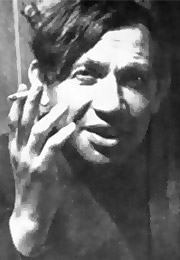


Oil on canvas
54.6 x 45.7 cm. (21 1/2 x 18 in.)
frame: 80.7 x 71.1 cm (31 3/4 x 28 in.)
1988.62.23
Signed lower left: Soutine
Jonas Netter (1867–1946), Paris; by descent to his widow, Madame Netter, Paris; sold to Henry Pearlman, by 11 July 1949; Henry and Rose Pearlman Foundation, 1983.
After his first purchase of a painting by Soutine, in 1945, Pearlman acquired several more works by the artist, including this exceptional Self-Portrait. While self-portraits usually show the artist glancing sideways toward a mirror, here Soutine depicted himself full face. The painter’s suit and tie are also unusual, lending him the appearance of a proper bourgeois gentleman instead of an artist at work. On the back of the canvas in front of him is a fragment of a portrait, perhaps also a self-portrait, suggesting a play between the two images.
My dealer friend [Vladimir Raykis, Galerie Zak] who had procured the Indenbaum Portrait had also arranged for me to see with him a famous collection in Paris. I had no more…
My dealer friend [Vladimir Raykis, Galerie Zak] who had procured the Indenbaum Portrait had also arranged for me to see with him a famous collection in Paris. I had no more than been introduced to the hostess [likely Madame Netter] when she asked whether I could do her a good turn in America where her daughter was visiting; I readily assented. My dealer friend then asked the hostess timidly whether she would sell me a Soutine, of which she owned a large number. She said yes, and brought out three of them without frames, one a self-portrait. I pointed to the self-portrait without asking the price, which the dealer negotiated quickly, whereupon he picked up the painting, put it under his arm, and literally forced me to leave with him immediately.
Ignoring my protests at leaving so suddenly without seeing the famous collection, the dealer explained to me that if I had stayed five minutes more the seller would have changed her mind. My friend knew what he was doing; by the time we had returned to his gallery, a telephone message was already waiting. On returning the call, the dealer had to purchase the painting a second time, by convincing the seller she had made a good deal. Unfortunately for me, while the Soutine portrait was still in Paris a representative of Skira Art Book Publications saw it at my friend’s gallery and had it reproduced in color. This color reproduction, published shortly after my purchase, convinced the seller that she had been unwise to part with it. The result was that I have never been able to get a return invitation to see the rest of her collection.

Chaïm Soutine (1893-1943)
Soutine was one of the leading figures of the early 20th-century international conglomerate of artists known as the School of Paris. He developed an idiosyncratic style that was derived from his study of Old Masters and infused with a modern sense of freedom, conveyed through pure color and boldly impastoed paint. The artist’s intense painterly manner influenced subsequent generations of painters, including Abstract Expressionists.
Soutine was born to an Orthodox Jewish family originally from Belarus and grew up in a Lithuanian ghetto. He was attracted to drawing at early age, and, despite protests from those in his community who believed in Talmudic proscriptions against images, he was determined to become an artist. He studied at a small academy in present-day Vilnius, where he learned about Russian art, including its avant-garde varieties. In 1913, Soutine moved to Paris, where he joined Fernand Cormon’s atelier. He found inspiration by studying in the Louvre directly from Old Masters such as Rembrandt, Tintoretto, Goya, and El Greco, as well as more recent masters such as Gustave Courbet.
In 1915, Soutine met Amedeo Modigliani through their mutual friend Jacques Lipchitz and soon became close to the Italian artist. Modigliani provided crucial encouragement to Soutine and included him in his infamous drinking sessions. As it was for Modigliani, portraiture was a significant subject for Soutine. The artist’s portraits often exaggerate certain features, including awkward poses and melancholy facial expressions, imparting an expressive urgency to his subjects. He sometimes worked on series of certain social types, making a number of versions of figures such as pastry cooks, bellboys, and choirboys dressed in their identifiable working clothes. The pathos evoked by such figures often suggested not only the subjects’ inner lives but also the weight of Soutine’s own gaze and feelings.
Soutine applied a similar kind of painterly intensity to his still-life paintings of food, which are often inflected with ritualistic overtones that allude to the artist’s religious upbringing, as well as traditional memento mori themes that relate to his own experience of enduring shortages of food while growing up. In 1918, Soutine was apparently encouraged by his dealer to travel to the Midi to pursue landscape painting. In Céret and its environs he painted dramatically contorted scenes of the land and towns. These paintings often had a visionary quality, featuring vortex-like spatial configurations and forceful brushwork. In 1923, the American collector Albert Barnes purchased approximately one hundred examples of Soutine’s work, bringing a sudden rise in prices and greater critical visibility, which allowed Soutine to support himself through his art for the rest of his life. During his final years, however, he suffered both from illness and from the consequences of hiding from the Nazis during their occupation of Paris and died of complications from surgery before the war was over.